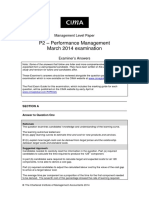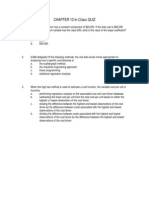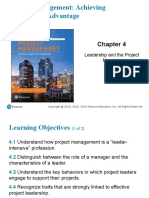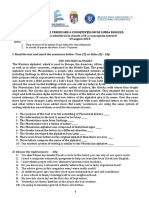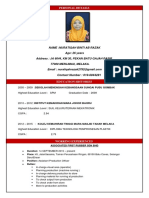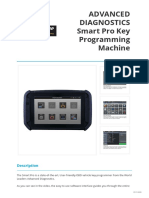P1 March2014 Answers
P1 March2014 Answers
Uploaded by
Gabriel KorleteyCopyright:
Available Formats
P1 March2014 Answers
P1 March2014 Answers
Uploaded by
Gabriel KorleteyOriginal Description:
Original Title
Copyright
Available Formats
Share this document
Did you find this document useful?
Is this content inappropriate?
Copyright:
Available Formats
P1 March2014 Answers
P1 March2014 Answers
Uploaded by
Gabriel KorleteyCopyright:
Available Formats
Operational Level Paper
P1 – Performance Operations
March 2014 examination
Examiner’s Answers
Note: Some of the answers that follow are fuller and more comprehensive than would be
expected from a well-prepared candidate. They have been written in this way to aid teaching,
study and revision for tutors and candidates alike.
These Examiner’s answers should be reviewed alongside the question paper for this
examination which is now available on the CIMA website at www.cimaglobal.com/p1papers
The Post Exam Guide for this examination, which includes the marking guide for each
question, will be published on the CIMA website by early April at
www.cimaglobal.com/P1PEGS
SECTION A
Answer to Question One
Rationale
Question One consists of eight objective test sub-questions. These are drawn from all
sections of the syllabus. They are designed to examine breadth across the syllabus and thus
cover many learning outcomes.
1.1 The correct answer is B.
1.2 (1 + r) x (1 + i) = (1 + m)
(1 + 0.06) x (1 + 0.03) = 1.0918
(1 + m) = 1.0918
m = 0.0918
m = 9.18%
The correct answer is D.
The Chartered Institute of Management Accountants 2014
1.3
Product R Product S Total
Budgeted production 80,000 60,000 140,000
per annum (units)
Number of batches 800 1,200 2,000
Number of machine 2,400 3,600 6,000
set-ups
Total processing time 240,000 300,000 540,000
(minutes)
Cost driver rate = $108,000 / 540,000 = $0.20
Total processing costs = $0.20 x 240,000 = $48,000
Processing costs per unit = $48,000 / 80,000 = $0.60
The correct answer is C.
1.4
Cost driver rate = $180,000 / 6,000 = $30 per set up
Total set-up costs = $30 x 3,600 = $108,000
Set up cost per unit =$108,000 / 60,000 = $1.80
The correct answer is B.
1.5
The profitability index = net present value of the investment / initial investment
= $140,500 / $500,000
= 0.281
The correct answer is C.
1.6 The expected value of cost of the warranty claims is:
$2,000,000 x 15% = $300,000
$6,000,000 x 3% = $180,000
$10,000,000 x 2% = $200,000
$680,000
Performance Operations 2 March 2014
1.7 Trade receivable at the end of this year = $862,860 x 55/365 = $130,020
Credit sales for next year = $862,860 x 1.05 = $906,003
Trade receivable days at end of next year = $130,020 / $906,003 x 365 = 52.38 days
1.8
(i)
The minimum profit at a selling price of $80 is $50,000
The minimum profit at a selling price of $90 is $60,000
The minimum profit at a selling price of $100 is $70,000
The minimum profit at a selling price of $110 is $75,000
Therefore if the manager wants to maximise the minimum profit a selling price of $110 would
be chosen.
(ii)
A regret matrix can be produced as follows:
Competitor Selling price
Reaction
$80 $90 $100 $110
Strong $10,000 $0 $10,000 $5,000
Medium $30,000 $20,000 $10,000 $0
Weak $10,000 $0 $10,000 $20,000
Maximum regret $30,000 $20,000 $10,000 $20,000
Therefore if the manager wants to minimise the maximum regret a selling price of $100 would
be chosen.
March 2014 3 Performance Operations
SECTION B
Answer to Question Two
(a)
Rationale
The question assesses learning outcome B3(b) apply alternative approaches to budgeting. It
examines candidates’ ability to explain the advantages and disadvantages of zero based
budgeting.
Suggested Approach
Candidates should clearly explain two advantages and one disadvantage of zero based
budgeting in the scenario described.
Examiner’s note: the question asks for two advantages and one disadvantage. Examples of
points that would be rewarded are given below.
Advantages
a) It avoids the complacency inherent in the traditional incremental approach where it is
assumed that future activities will be very similar to current ones.
b) It encourages a questioning approach by focusing attention not only on the cost of the
activity but on the benefits is provides. This will force the public sector managers to
articulate the benefits encouraging them to think clearly about the activities.
c) Preparation of decision packages will normally require the involvement of many
employees. This involvement may produce many ideas and promote job satisfaction.
Disadvantage
a) The creation of decision packages and their subsequent ranking is very time consuming
and costly. The public sector organisation will need to assess whether the benefits of
the system outweigh the costs involved.
b) The ranking process is very difficult and value judgements are inevitable. In a public
sector organisation the decision packages are very disparate and difficult to compare.
c) In applying ZBB ‘activities’ may continue to be identified with traditional functional
departments rather than cross functional activities and thus distract attention from the
real cost-reduction issues.
Performance Operations 4 March 2014
(b)
Rationale
The question assesses learning outcome D1(e) calculate the value of information. It
examines candidates’ ability to calculate the value of perfect information where there is
uncertainty regarding expected cash flows.
Suggested Approach
Candidates should firstly apply the probabilities for the economic conditions to calculate the
expected value of the net present value (NPV) for each of the projects without perfect
information. They should then select the best outcome for each of the possible economic
conditions and apply the probabilities to these to calculate the expected value with perfect
information. The value of perfect information can then be calculated as the difference
between the expected value with perfect information and the best of the expected values
without perfect information.
Economic
Project A Project B Project C
Conditions
$000 $000 $000
Good (30%) 700 800 700
Fair (20%) 400 500 600
Poor (50%) 300 400 500
Expected values ($000)
Project A ($700 x 0.3) + ($400 x 0.2) + ($300 x 0.5) = $440
Project B ($800 x 0.3) + ($500 x 0.2) + ($400 x 0.5) = $540
Project C ($700 x 0.3) + ($600 x 0.2) + ($500 x 0.5) = $580
On the basis of expected value Project C would be chosen.
Expected value with perfect information ($000)
If good select Project B = ($800 x 0.3) = $240
If fair select Project C = ($600 x 0.2) = $120
If poor select Project C = ($500 x 0.5) = $250
Expected value with perfect information is $240 + $120 + $250 = $610
The maximum amount that should be paid is ($610k – $580k) = $30k
March 2014 5 Performance Operations
(c)
Rationale
Part (i) assesses learning outcome E1(e) analyse trade debtor and creditor information. It
examines candidates’ ability to calculate the effective annual interest rate of an early
settlement discount. Part (ii) assesses learning outcome E1(f) analyse the impacts of
alternative debtor and creditor policies. It examines candidates’ ability to identify methods that
could be used to reduce a company’s trade receivable days.
Suggested Approach
In part (i) candidates should calculate how many days early the payment will be received.
They should then divide 365 days by this to calculate the number of compounding periods.
The discount rate should then be compounded by the number of periods to calculate the
effective annual interest rate. In part (ii) candidates should clearly state two methods that
could be used to reduce a company’s trade receivable days.
(i)
Payment will be made 45 days early.
Number of compounding periods = 365/45= 8.111
8.111
1+ r = (1.00/0.98)
1+ r = 1.17805
The effective annual interest rate of the early settlement discount is 17.81%
(ii)
Examiner’s note: the question asks for two methods. Examples of methods that would be
rewarded are given below.
a) Interest penalties for late payment
b) Improved credit control procedures
c) Reduce the credit terms
Performance Operations 6 March 2014
(d)
Rationale
The question assesses learning outcome E1(g) analyse the impacts of alternative policies for
stock management. Part (i) examines candidates’ ability to calculate the economic order
quantity (EOQ) for a product. Part (ii) requires candidates to calculate the total inventory
holding and ordering costs if the company uses the EOQ.
Suggested Approach
In part (i) candidates should apply the formula for the EOQ given in the question paper to the
figures given in the question in order to calculate the EOQ. In part (ii) candidates should firstly
calculate the total number of orders that would be required if the EOQ was used. This can
then be multiplied by the ordering costs per order to calculate the total ordering costs. In
order to calculate the holding costs the EOQ should be divided by two to calculate the
average inventory held. This should then be multiplied by the holding cost per unit to
calculate the total holding costs. The total ordering cost and total holding costs can then be
added together.
2C o D
(i) EOQ =
Ch
Where:
Co (cost per order) = $150
D = (annual demand) = 30,000 units
Ch = (cost of holding one unit for one year) = $25
2 × 150 × 30, 000
EOQ = = 600 units
25
(ii)
Number of orders = 30,000 / 600 = 50 per year
Ordering costs = 50 x $150 = $7,500
Holding costs = 600 x 0.5 x $25 = $7,500
Total ordering and holding costs = $15,000
March 2014 7 Performance Operations
(e)
Rationale
The question assesses learning outcome A3(a) apply principles of environmental costing in
identifying relevant internalised costs and externalised environmental impacts of the
organisation’s activities. It examines candidates’ ability to explain the benefits to a company
from using an environmental costing system.
Suggested Approach
Candidates should clearly explain three benefits that may arise for a company that uses an
environmental costing system.
Examiner’s note: the question asks for three benefits. Examples of points that would be
rewarded are given below.
Increased awareness of the impact of environment related activities on their financial
statements
Organisations that use an environmental costing system will have greater awareness of the
impact of environment related activities on their financial statements. This is because
conventional management accounting systems tend to attribute many environmental costs to
general overhead accounts with the result that they are “hidden” from management.
Cost control / reduction
Organisations which adopt environmental cost management principles are more likely to
identify and take advantage of cost reduction and other improvement opportunities. Identifying
and monitoring the usage and cost of resources such as water, electricity and fuel will result
in better control of the cost of these resources and identification of potential for cost reduction.
More accurate product costs / improved decision making
A good environmental costing system will produce more accurate product costs. This will
reduce the chances of employing incorrect pricing of products and services and taking the
wrong options in terms of mix and development decisions. Lack of cost information can result
in the cross subsidisation of environmentally damaging products.
Environmental risk management
Improved environmental cost information will enable environmental considerations to form
part of investment decisions. The likelihood and impact of environmental risks can also be
assessed.
Performance Operations 8 March 2014
(f)
Rationale
Part (i) of the question assesses learning outcome E2(d) illustrate numerically the financial
impact of short-term funding and investment methods. Part (ii) assesses learning outcome
E2(b) identify alternatives for investment of short-term cash surpluses. Part (i) examines
candidates’ ability to calculate the issue price of a bill of exchange. Part (ii) requires
candidates to state two ways in which an accepted bill of exchange can be used by the
holder.
Suggested Approach
In part (i) candidates should calculate the discount on the bill by multiplying the face value by
the discount yield for 91 days. The discount on the bill should then be subtracted from the
face value to calculate the issue price. In part (ii) candidates should clearly state two ways in
which an accepted bill of exchange can be used by the holder.
(i)
If the discount yield is 6% then the discount on the bill will be:
$1,000 x 0.06 x 91/365 = $14.96
The issue price of the bill is therefore:
$1,000 - $14.96 = $985.04
(ii)
Examiner’s note: the question asks for two ways. Examples of points that would be rewarded
are given below.
The holder of an accepted bill of exchange can do one of the following:
(i) Hold the bill until the due date and collect the money
(ii) Discount the bill with the bank for immediate payment
(iii) Transfer the bill to a third party in settlement of an amount due.
March 2014 9 Performance Operations
SECTION C
Answer to Question Three
Rationale
The question assesses a number of learning outcomes. Part (a) assesses learning outcome
A1(d) apply standard costing methods, within costing systems, including the reconciliation of
budgeted and actual profit margins. It examines candidates’ ability to calculate appropriate
variances to enable the reconciliation of budgeted and actual profit. Part (b) assesses
learning outcome A1(f) interpret material, labour, variable overhead, fixed overhead and
sales variances, distinguishing between planning and operational variances. It examines
candidates’ ability to discuss the reasons the variances may have arisen and the possible
interrelationship between the variances. Part (c) assesses learning outcome A1(h) explain
the impact of just-in-time manufacturing methods on cost accounting and the use of ‘back-
flush accounting’ when work in progress stock is minimal. It examines candidates’ ability to
explain the reasons why standard costing may not be considered useful in a modern
manufacturing environment.
Suggested Approach
In part (a) candidates should firstly calculate the budgeted profit and the actual profit for the
period. They should then calculate each of the variances for sales, material, labour and
production overheads. They should then prepare a reconciliation statement starting with the
budgeted profit and then showing each of the individual variances to reconcile the budgeted
profit to actual profit. In part (b) candidates should discuss the effect that the Production
Director’s decision has had on the company performance as shown by the variances.
In part (c) candidates should clearly explain the reasons why standard costing may not be
considered useful in a modern manufacturing environment.
Performance Operations 10 March 2014
(a) (i) Reconciliation statement for February
$ $
Budgeted gross profit
60,000
(1,000 units x $60)
Sales volume profit variance
12,000 F
(1,200 units - 1,000 units) x $60
Sales price variance
7,200 F
1,200 units x ($306 - $300)
Direct material price variance
66,000 A
22,000 mtrs x ($9 - $12)
Direct material usage variance
9,000 A
((1,400 x 15 mtrs) – 22,000 mtrs) x $9
Direct labour rate variance
20,400 A
6,800 hours x ($12 - $15)
Direct labour efficiency variance
2,400 F
((1,400 x 5 hrs) – 6,800) x $12
Variable overhead expenditure variance
7,800 F
(6,800 x $6) – $33,000
Variable overhead efficiency variance
1,200 F
((1,400 x 5 hrs) – 6,800) x $6
Fixed overhead expenditure variance
3,000 A
(1,000 x $15) - $18,000
Fixed overhead volume variance
6,000 F
((1,400 – 1,000 x 5 hrs) x $3)
Actual gross profit /(loss) (1,800)
Workings:
Actual gross profit for the period
$
Sales 1,200 units x $306 367,200
Direct materials 22,000 metres x $12 264,000
Direct labour 6,800 hours x $15 102,000
Variable production overheads 33,000
Fixed production overheads 18,000
Closing stock 200 units x $240 (48,000)
Actual gross profit (1,800)
(b)
The Production Director’s decision has resulted in a favourable sales volume variance of
$12,000 and a favourable sales price variance of $7,200 F which may at least partly be as a
result of the improved quality of the product. However, the favourable sales variances have
been achieved at a very high cost in terms of material and labour.
The Production Director’s decision has resulted in a total material cost variance of $75,000 A
and a total labour cost variance of $18,000 A. The material price variance is adverse due to
the purchase of higher quality materials. However, there is also an adverse material usage
variance which may be because the labour force was unfamiliar with handling the new
material. The decision to use higher skilled labour has resulted in an adverse labour rate
variance which has been only partially offset by a favourable labour efficiency variance.
March 2014 11 Performance Operations
(c)
In a JIT environment measuring standard costing variances may encourage dysfunctional
behaviour. A JIT production environment relies on producing small batch sizes economically
by reducing set up times. Performance measures that benefit from large batch sizes or
producing for inventory should therefore be avoided.
In an AMT environment the major costs are those related to the production facility rather than
production volume related costs such as materials and labour, which standard costing is
essentially designed to plan and control. Fixed overhead variances don’t necessarily reflect
under or overspending but may simply reflect differences in production volume. An activity
based cost management system may be more appropriate, focusing on the activities that
drive the cost.
In a total quality environment, standard costing variance measurement places an emphasis
on cost control to the detriment of quality. Cost control may be achieved at the expense of
quality and competitive advantage.
A continuous improvement environment requires a continual effort to do things better rather
than achieve an arbitrary standard based on prescribed or assumed conditions. In today’s
competitive environment cost is market driven and is subject to considerable downward
pressure. Cost management must consist of both cost maintenance and continuous cost
improvement.
In a JIT/AMT/TQM environment the workforce is usually organised into empowered, multi-
skilled teams controlling operations autonomously. The feedback they require is real time.
Periodic financial reports are neither meaningful nor timely enough to facilitate appropriate
control action.
Performance Operations 12 March 2014
Answer to Question Four
Rationale
Part (a) assesses learning outcomes C1(b) apply the principles of relevant cash flow analysis
to long-run projects that continue for several years and C2(a) evaluate project proposals
using the techniques of investment appraisal. It examines candidates’ ability to identify the
relevant costs of a project and then apply discounted cash flow analysis to calculate the net
present value of the project. Part (b) assesses learning outcome C1(g) prepare decision
support information for management, integrating financial and non-financial considerations. It
examines candidates’ ability to explain other factors that the company would need to consider
before deciding whether to go ahead with the project. Part (c) assesses learning outcome
C2(c) prioritise projects that are mutually exclusive, involve unequal lives and/or are subject
to capital rationing. It examines candidates’ ability to determine the optimum replacement
cycle for a company’s non-current assets.
Suggested Approach
In part (a) candidates should firstly calculate the gross profit that would be earned in each
year from the online shopping service and deduct the lost profit from existing in-store sales.
They should then deduct the payments to PQ and the other operating costs and add on the
lease income. The tax depreciation and tax payments should then be calculated. The total
cost of the investment, the residual value should be added to the net cash flows. The net
cash flows after tax should then be discounted at the discount rate of 12% to calculate the net
present value (NPV) of the project. In part (b) candidates should clearly explain two other
factors that the company would need to consider before deciding whether to go ahead with
the project. In part (c) candidates should calculate the NPV of the cash flows under each of
the three alternatives. They should then divide the NPV by the appropriate annuity factor to
calculate the annualised equivalent cost. The optimum replacement cycle can then be
selected as the alternative with the lowest annualised equivalent cost.
(a)
Gross profit Years 1 – 5
Year 1: 100,000 customers x 52 weeks x $200 = $1,040m x 20% = $208m
Year 2: 120,000 customers x 52 weeks x $200 = $1,248m x 20% = $250m
Year 3: 150,000 customers x 52 weeks x $200 = $1,560m x 20% = $312m
Year 4: 160,000 customers x 52 weeks x $200 = $1,664m x 20% = $333m
Year 5: 170,000 customers x 52 weeks x $200 = $1,768m x 20% = $354m
Taxation
Year 1 Year 2 Year 3 Year 4 Year 5
$m $m $m $m $m
Gross profit 208 250 312 333 354
Lost profit from (62) (75) (94) (100) (106)
existing sales
Other operating (60) (65) (70) (75) (80)
costs
Lease income 20 20 20 20 20
Fee to PQ (30) (30) (30) (30) (30)
Fee to PQ (2) (3) (3) (3) (4)
Net cash flows 74 97 135 145 154
Tax depreciation (4) (3) (2) (2) (4)
Taxable profit 70 94 133 143 150
Taxation @ 30% 21 28 40 43 45
March 2014 13 Performance Operations
Net present value
Year 0 Year 1 Year 2 Year 3 Year 4 Year 5 Year 6
$m $m $m $m $m $m $m
Investment (445) 350
/ residual
value
Net cash 74 97 135 145 154
flows
Tax (11) (14) (20) (22) (23)
payment
Tax (10) (14) (20) (21) (22)
payment
Net cash (445) 63 73 101 103 460 (22)
flow after
tax
Discount 1.000 0.893 0.797 0.712 0.636 0.567 0.507
factors @
12%
Present (445) 56 58 72 66 261 (11)
value
Net present value = $57m
The net present value is positive therefore the project should go ahead.
(b)
Two other factors that the company would need to consider are:
Quality/ reliability: can the online retailer provide the quality and reliability of service that LM’s
customers will expect?
Financial strength of PQ: LM is reliant on PQ being able to provide the IT technology and
delivery service to its customers for at least the five year period of the contract.
(c)
Replace after Year 1 Replace after Year 2 Replace after Year 3
Year Discount Cash Present Cash Present Cash Present
Factor flows value flows value flows value
@12% $ $ $ $ $ $
0 1.000 (25,000) (25,000) (25,000) (25,000) (25,000) (25,000)
1 0.893 10,000 8,930 (6,000) (5,358) (6,000) (5,358)
2 0.797 2,000 1,594 (8,000) (6,376)
3 0.712 (8,000) (5,696)
Net (16,070) (28,764) (42,430)
present
value
Cumulative 0.893 1.690 2.402
discount
factor
Annualised (17,996) (17,020) (17,664)
equivalent
The lowest annualised equivalent cost occurs if the vehicles are kept for two years. Therefore
the optimum replacement cycle is to replace the vehicles every two years.
Performance Operations 14 March 2014
You might also like
- P1 May 2011 AnswersDocument13 pagesP1 May 2011 AnswersmavkaziNo ratings yet
- P1 May 2014 Answers Final For WebDocument16 pagesP1 May 2014 Answers Final For WebLiyana ChuaNo ratings yet
- P1 - Performance Operations: Operational Level PaperDocument14 pagesP1 - Performance Operations: Operational Level PapermavkaziNo ratings yet
- Transfer PricingDocument2 pagesTransfer PricingAva DasNo ratings yet
- Modul Jawaban Koeliah: Akuntansi BiayaDocument16 pagesModul Jawaban Koeliah: Akuntansi BiayaAndika Putra SalinasNo ratings yet
- DocxDocument5 pagesDocxBecky GonzagaNo ratings yet
- Quiz1 DMC AnswersDocument7 pagesQuiz1 DMC Answersmaden100% (1)
- PM Sect B Test 5Document3 pagesPM Sect B Test 5FarahAin FainNo ratings yet
- 610 Exam 2 Spring 11 PracticeDocument8 pages610 Exam 2 Spring 11 PracticeSummerNo ratings yet
- P2 March2014 AnswersDocument16 pagesP2 March2014 Answersjoelvalentinor100% (3)
- Peg Sept11 p1Document18 pagesPeg Sept11 p1patriciadouceNo ratings yet
- 2016 Management AccountingDocument9 pages2016 Management AccountingВероника КулякNo ratings yet
- FinalexamDocument12 pagesFinalexamJoshua GibsonNo ratings yet
- Examiner's Report: MA/FMA Management AccountingDocument9 pagesExaminer's Report: MA/FMA Management AccountingFayaz AhmedNo ratings yet
- Take Home Final Exam1Document4 pagesTake Home Final Exam1Sindura RamakrishnanNo ratings yet
- P2 Nov 09 PegDocument17 pagesP2 Nov 09 PegSatvir KaurNo ratings yet
- PM Examreport m19Document13 pagesPM Examreport m19Sakhi AhmadyarNo ratings yet
- Answers To 3Document6 pagesAnswers To 3Nandy Raghoo GopaulNo ratings yet
- MA Final Exam Prep Sample 4 PDFDocument18 pagesMA Final Exam Prep Sample 4 PDFbooks_sumiNo ratings yet
- FR SD20 Examiner's ReportDocument21 pagesFR SD20 Examiner's Reportngoba_cuongNo ratings yet
- Week 2 Tutorial SolutionsDocument5 pagesWeek 2 Tutorial Solutionsduraton94No ratings yet
- Assignment 2Document6 pagesAssignment 2Devesh MauryaNo ratings yet
- Acc 491Document7 pagesAcc 491Maitham_Ali_3219No ratings yet
- 2018 Management Accounting Ibm2 PrepDocument9 pages2018 Management Accounting Ibm2 PrepВероника КулякNo ratings yet
- Managerial Accounting Solutions Chapter 3 PDFDocument42 pagesManagerial Accounting Solutions Chapter 3 PDFadam_garcia_81No ratings yet
- Assignment COST ACCDocument11 pagesAssignment COST ACCprotaiskigali100% (1)
- Exam61 05Document9 pagesExam61 05Rabah ElmasriNo ratings yet
- ISV Managerial Accounting, 4e: Final Exam: Chapters 1-14Document85 pagesISV Managerial Accounting, 4e: Final Exam: Chapters 1-14Mikaela SeminianoNo ratings yet
- Acc 5120Document6 pagesAcc 5120manjinderchabba100% (1)
- CHAPTER 10 In-Class QUIZDocument17 pagesCHAPTER 10 In-Class QUIZAnkit SuriNo ratings yet
- Answer To MTP - Intermediate - Syllabus 2012 - Dec2014 - Set 1Document16 pagesAnswer To MTP - Intermediate - Syllabus 2012 - Dec2014 - Set 1Crizhae OconNo ratings yet
- f5 Mock 1Document20 pagesf5 Mock 1Salome farrenNo ratings yet
- CA IPCC Costing Nov 14 Guideline Answers PDFDocument13 pagesCA IPCC Costing Nov 14 Guideline Answers PDFmohanraokp2279No ratings yet
- Answers Homework # 13 Cost MGMT 2Document6 pagesAnswers Homework # 13 Cost MGMT 2Raman ANo ratings yet
- Final ExamDocument12 pagesFinal ExamTomoko KatoNo ratings yet
- ACYMAG1 Exercise Set #3 - 2T2223Document6 pagesACYMAG1 Exercise Set #3 - 2T2223kyle turlaNo ratings yet
- CMA CPA 2006 Mock ExamsDocument86 pagesCMA CPA 2006 Mock ExamsRaphael Wong100% (1)
- SCM SolutionDocument10 pagesSCM SolutionLy TuyếtNo ratings yet
- Herbert Economics AssDocument13 pagesHerbert Economics AssEmmanuel NamkumbeNo ratings yet
- SunwayTes Management Accountant Mock E2Document10 pagesSunwayTes Management Accountant Mock E2FarahAin FainNo ratings yet
- Final Solution Winter 2017Document27 pagesFinal Solution Winter 2017sunkenNo ratings yet
- CMA 2013 SampleEntranceExam Revised May 15 2013Document77 pagesCMA 2013 SampleEntranceExam Revised May 15 2013Ava DasNo ratings yet
- CM231.MAC (IL-II) Solution CMA January-2023 Exam.Document5 pagesCM231.MAC (IL-II) Solution CMA January-2023 Exam.Shawn MehdiNo ratings yet
- 1 5 ChaptersDocument8 pages1 5 ChaptersshahabNo ratings yet
- Examination Paper: Instruction To CandidatesDocument11 pagesExamination Paper: Instruction To CandidatesNikesh MunankarmiNo ratings yet
- 2011 Solutions To Practice Questions StudentsDocument13 pages2011 Solutions To Practice Questions StudentsnnasikerabuNo ratings yet
- CIMA p1 March 2011 Post Exam GuideDocument18 pagesCIMA p1 March 2011 Post Exam GuidearkadiiNo ratings yet
- F2 Mock Answers 1Document16 pagesF2 Mock Answers 1ShruthiNo ratings yet
- Cost Accounting Test Bank CKDocument12 pagesCost Accounting Test Bank CKLeo Tama67% (9)
- Final Exam, s2, 2018-FINALDocument11 pagesFinal Exam, s2, 2018-FINALShivneel Naidu0% (1)
- Rubica - Acc123 Final ExamDocument30 pagesRubica - Acc123 Final ExammarietorianoNo ratings yet
- Practice Exam 2 - Sp2r 201022Document12 pagesPractice Exam 2 - Sp2r 201022ATLASNo ratings yet
- Practice ExamDocument57 pagesPractice ExamShivam GujralNo ratings yet
- Budget ADocument15 pagesBudget Ayahoo2008No ratings yet
- Gls University'S Faculty of Commerce Semester - Iv Cost Accounting - 2 Objective Questions 2017-2018Document12 pagesGls University'S Faculty of Commerce Semester - Iv Cost Accounting - 2 Objective Questions 2017-2018Archana0% (1)
- Real Estate Math Express: Rapid Review and Practice with Essential License Exam CalculationsFrom EverandReal Estate Math Express: Rapid Review and Practice with Essential License Exam CalculationsNo ratings yet
- Achievements and Skills Showcase Made Easy: The Made Easy Series Collection, #4From EverandAchievements and Skills Showcase Made Easy: The Made Easy Series Collection, #4No ratings yet
- Pinto pm5 Inppt 07Document19 pagesPinto pm5 Inppt 07Gabriel KorleteyNo ratings yet
- Pinto pm5 Inppt 06Document21 pagesPinto pm5 Inppt 06Gabriel KorleteyNo ratings yet
- Pinto pm5 Inppt 03Document31 pagesPinto pm5 Inppt 03Gabriel Korletey0% (1)
- Pinto pm5 Inppt 04Document31 pagesPinto pm5 Inppt 04Gabriel KorleteyNo ratings yet
- Pinto pm5 Inppt 02-1-1Document32 pagesPinto pm5 Inppt 02-1-1Gabriel KorleteyNo ratings yet
- Pinto pm5 Inppt 01Document34 pagesPinto pm5 Inppt 01Gabriel KorleteyNo ratings yet
- FULL SOLUTION TO AUDITING TUTORIAL QUESTIONSsDocument17 pagesFULL SOLUTION TO AUDITING TUTORIAL QUESTIONSsGabriel KorleteyNo ratings yet
- P1 March 2014 QPDocument20 pagesP1 March 2014 QPGabriel KorleteyNo ratings yet
- Airbus ESLD ECAM System Logic DataDocument3,736 pagesAirbus ESLD ECAM System Logic DataCdr. Pearl100% (2)
- Clase 11 Past Continue AfirmativeDocument14 pagesClase 11 Past Continue Afirmativekatty lauraNo ratings yet
- Draft Documents For Incorporation of Company Using SPICe FormDocument28 pagesDraft Documents For Incorporation of Company Using SPICe FormRam Iyer100% (1)
- Lean Six Sigma Yellow Belt Training Material - 2024Document103 pagesLean Six Sigma Yellow Belt Training Material - 2024fiscalrfb22No ratings yet
- Daria 27 Mai FacutDocument3 pagesDaria 27 Mai FacutSimona Diana MicuNo ratings yet
- District 6 Master Contract 19-20 Final PDFDocument66 pagesDistrict 6 Master Contract 19-20 Final PDFEmilyNo ratings yet
- Socio-Cultural BrainDocument56 pagesSocio-Cultural BrainRajat Raj VermaNo ratings yet
- Unit 2: Bioenergetics, Biosystems and ApplicationsDocument9 pagesUnit 2: Bioenergetics, Biosystems and ApplicationsTravis SatnarineNo ratings yet
- Teen Sexting Legal TreatmentDocument12 pagesTeen Sexting Legal TreatmentFer Gom BNo ratings yet
- Philo Subject Orientation - PPTX (Autosaved)Document28 pagesPhilo Subject Orientation - PPTX (Autosaved)jason de jesusNo ratings yet
- Ammanford Nursery School ProspectusDocument25 pagesAmmanford Nursery School ProspectusChristopherJonesNo ratings yet
- Name:Nuratiqah Binti Ab Razak Age: 26 Years Address: Ja 6644, KM 30, Pekan Batu Gajah Pasir, 77300 Merlimau, MelakaDocument2 pagesName:Nuratiqah Binti Ab Razak Age: 26 Years Address: Ja 6644, KM 30, Pekan Batu Gajah Pasir, 77300 Merlimau, MelakaEykha RazakNo ratings yet
- Speaking B1Document3 pagesSpeaking B120t1020294No ratings yet
- Centrifugal Juicer Extractor Santos 68Document4 pagesCentrifugal Juicer Extractor Santos 68Sce Dgp100% (1)
- Quarter 3 - Module 8 (Quiz 3.13)Document2 pagesQuarter 3 - Module 8 (Quiz 3.13)Jordan FedericoNo ratings yet
- GAD Orientation For Teachers and StakeholdersDocument4 pagesGAD Orientation For Teachers and StakeholdersS Ir ALNo ratings yet
- MBUS AssignmentDocument11 pagesMBUS AssignmentAh Boo33% (3)
- Psalm 23 Literary ElementsDocument3 pagesPsalm 23 Literary ElementsJunior PayatotNo ratings yet
- Priti Patel LetterDocument2 pagesPriti Patel LetterHarry ColeNo ratings yet
- Alfa Laval M-Line-10 IntroductionDocument2 pagesAlfa Laval M-Line-10 Introductionkevin shiNo ratings yet
- Modern Cataract Surgery Kohnen 2002Document253 pagesModern Cataract Surgery Kohnen 2002Kai SanNo ratings yet
- Union Galva Steel FinalDocument11 pagesUnion Galva Steel FinalAnonymous 0zrCNQNo ratings yet
- Christmas HolidaysDocument3 pagesChristmas HolidaysAngela A. CălinNo ratings yet
- Introduction To PegaCALLDocument15 pagesIntroduction To PegaCALLPrashu PagidiNo ratings yet
- Florida Camps and Group Homes 18feb18Document22 pagesFlorida Camps and Group Homes 18feb18eyelovelaNo ratings yet
- Regulated Bioanalysis - Fundamentals An PDFDocument239 pagesRegulated Bioanalysis - Fundamentals An PDFpundalikNo ratings yet
- 10DTF1 - Assessment 2 - Meeka WilliamsDocument6 pages10DTF1 - Assessment 2 - Meeka WilliamsMeeka WilliamsNo ratings yet
- DR Shailendra Dwivedi 15022011Document7 pagesDR Shailendra Dwivedi 15022011shailendra_dwiv2374No ratings yet
- Advanced Diagnostics Smart Pro Key Programming Machine: DescriptionDocument4 pagesAdvanced Diagnostics Smart Pro Key Programming Machine: DescriptionJimmy Brian KaifitiNo ratings yet
- Rajasthan Government Health Scheme: SR. NoDocument6 pagesRajasthan Government Health Scheme: SR. Noatipriya choudharyNo ratings yet









